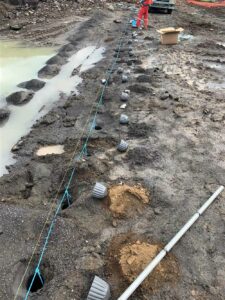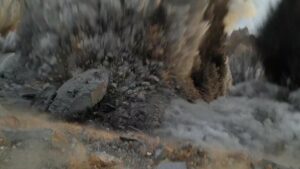
Scaled Depth of Burial Explained
The article explores the concept of scaled depth of burial (SD) and its significance in mitigating environmental impacts associated with blasting activities in mining and
In blasting, every metre of advance and every ton of ore or aggregate matters. Mines, quarries, and construction crews face daily challenges: uneven breakage, flyrock, airblast limits, and constant pressure on time and cost. The choice of a stemming device directly impacts safety, energy retention, and downstream productivity.
To test what works best in the field, we put two stemming plug devices, Varistem and RockRivet, side by side, comparing cost, fit, explosive compatibility, and results.
Varistem’s pricing ranges from approximately $1.00 to $16.13 (around R17.00 to R280.00) per plug, depending on the diameter. The cost scales predictably with hole diameter, which makes budgeting clean and repeatable.
The RockRivet’s pricing ranges from $1.48 to $7.70 (R25 to R135.14) depending on the diameter and rigidity of the stemming plug.
Varistem plugs follow a strict diameter-based price ladder — from about $1.00 for the smallest sizes up to $16.13 for 10″ holes — making costs predictable and easy to budget. RockRivet plugs start at $1.48, with heavier or rigid models stepping up to $7.70.
Unlike Varistem, RockRivet pricing depends more on the rigidity than on the exact hole diameter, adding more complexity.
Varistem coverage ranges from 1.75″ to 10″ (approximately 45–251 mm) across size codes BP2–BP10, with defined fit windows at each step.
RockRivet comes in class bands: 3–4.5″ (≈76–114 mm), 4.5–6″ (≈114–152 mm) and 6.5–9″ (≈165–229 mm), with rigid and semi-rigid options to suit wall roughness and hold.
For operations where every hole must be tightly matched — such as in hard rock mines aiming for maximum energy confinement — Varistem’s fine size ladder gives predictable, repeatable fits across diameters from 1.75″ to 10″. In contrast, RockRivet’s broader class bands cover multiple diameters with fewer models, making them practical where drilling tolerances vary or when crews need faster, simpler installs.
Varistem plugs are compatible with ANFO, emulsions and other common commercial explosives. Use ANFO in dry holes; in damp holes, use emulsion or watergel or heavy ANFO. Varistem also supports air-decking, which significantly reduces the amount of blasting material required for each blast.
RockRivet is a mechanical spider plug; its performance relies on its physical design, not on explosive chemistry. It is explicitly listed as working with ANFO and emulsion, helping to reduce slumping and minimise wastage of these explosives.
Both stemming plugs are proven with ANFO and emulsion, which remain the most common commercial explosives in mining and quarry blasting. Varistem has documented use with ANFO in dry holes and emulsion, watergel, or heavy ANFO in damp or flooded conditions, and it also supports air-decking for explosive savings.
RockRivet is explicitly listed as compatible with ANFO and emulsion, reducing slumping and wastage.
Varistem® plugs are dip-moulded, giving them flexibility and high tear strength. On detonation, the initial shockwave forces the plug upward into the stemming, creating a temporary pressure seal in the blasthole.
This momentary confinement pushes more energy into microfractures in the surrounding rock, weakening the rock mass before the burning front destroys the plug. The result is stronger confinement of the initial shockwave, cleaner fragmentation, and improved energy use in the rock.
RockRivet works differently: its rigid or semi-rigid spider legs bite into the borehole wall, creating a mechanical interference fit. Semi-rigid models allow for faster insertion in cleaner holes, while rigid models hold more securely in rough or over-gauge bores.
Built-in channels guide shock-tubes and detonation cord, reducing the risk of cut-offs during stemming. This makes RockRivet quick to install and reliable for column retention, though it doesn’t provide the same temporary pressure-seal effect as Varistem.
Varistem delivers its advantage by briefly sealing the blasthole at detonation, driving more of the initial shockwave into the rock for better breakage, while RockRivet’s value lies in its quick placement and reliable column retention through rigid or semi-rigid legs. Varistem helps energy retention and energy distribution; RockRivet, helps with energy distribution only.
Varistem is proven in the field. The underground platinum mine trial showed a consistent 11% increase in advance per blast, lifting average advance from 2.46 m to 2.82 m and translating into an annual net benefit of R1.91 billion from improved ore recovery.
Varistem has been credited across operations with up to 80% less flyrock, 87% better cast, 14%+ higher crusher throughput, over $10 million per year in added value, $1.45 million savings from reduced waste, and 8% faster loading in various studies.
At present, RockRivet’s performance is supported mainly by vendor descriptions of its mechanical design and benefits such as reduced ANFO/emulsion slumping and reliable column retention. However, there are no published independent case studies or peer-reviewed trials that quantify outcomes like flyrock reduction, fragmentation improvement, or cost savings.
Varistem offers published field cases, while RockRivet looks promising in demos.
Varistem is best chosen when the blast demands maximum collar confinement, precise hole matching, and proven productivity gains. Its fine size ladder ensures predictable fits across a wide range of diameters.
This makes it especially valuable in hard rock or high-value operations where energy retention and control of fragmentation are critical. Varistem also enables air decking, giving crews flexibility. It is the go-to option when consistency, control, and documented performance improvements are required.
RockRivet is best used where crews need reliable column retention in variable hole conditions. Its rigid and semi-rigid models let blasters adapt quickly: rigid versions grip harder in rough or over-gauge holes.
In contrast, semi-rigid versions insert more easily into clean, consistent bores. Built-in channels guide downlines safely through the plug, reducing the risk of cut-offs or misfires during stemming.
Both Varistem and RockRivet have a place in modern blasting. Varistem stands out where evidence and precision matter most: it offers a predictable size ladder, documented case studies, and proven gains in fragmentation, flyrock control, and downstream productivity. RockRivet provides practical value in variable hole conditions, giving crews flexible rigid or semi-rigid options and built-in downline protection for reliable column retention.
The difference is in the evidence. Varistem is backed by published field trials that quantify its benefits, while RockRivet’s strengths remain vendor-driven and need site testing to confirm results under local conditions.
For operations making critical production and safety decisions, that distinction is important. Ultimately, the right stemming plug depends on whether your priority is proven performance and accuracy or practical placement and adaptability.
ERG Industrial offers in-depth advice on stemming plugs and other blasting equipment. Contact us for a quote to see how your blasting team can benefit from Varistem.

The article explores the concept of scaled depth of burial (SD) and its significance in mitigating environmental impacts associated with blasting activities in mining and

Blasts that lose energy retention result in additional costs, uneven breakage, noise, and increased drilling and explosives. The choice in your stemming device dramatically impacts

This article delves into the causes, effects, and mitigation measures related to flyrock incidents. It emphasises the importance of understanding mechanisms like face bursting, cratering,